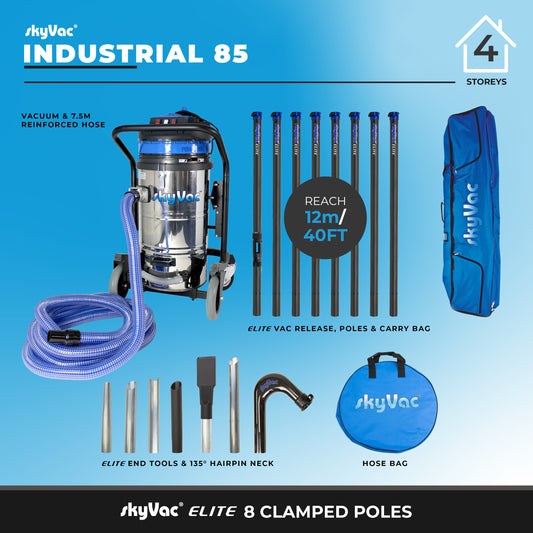Understanding Combustible Dust and Its Hazards
Share
Combustible Dust Defined by NFPA
The National Fire Protection Association (NFPA) defines combustible dust as any particulate solid that can ignite or cause a deflagration hazard when suspended in air or another oxidizing medium, regardless of particle size or shape.
Characteristics of Combustible Dust
Particles with a diameter of 420 micrometers or smaller are generally considered combustible dust. Both natural and synthetic organic materials, as well as certain metals, can form such dust. The NFPA’s Industrial Fire Hazards Handbook notes, “Any industrial process that reduces a combustible material and some normally non-combustible materials to a finely divided state presents a potential for a serious fire or explosion.”

Types of Combustible Dust
Combustible dusts are classified as Class II and further divided into Groups E, F, and G, each posing unique hazards:
- Group E: Metal dusts like aluminum and magnesium, which are abrasive and conductive.
- Group F: Carbonaceous dusts, including coal, which have lower ignition temperatures and are semi-conductive.
- Group G: Dusts from chemicals, food, grain, and plastics, which are non-conductive and have the lowest ignition temperatures.
Divisions of Combustible Dust Locations
- Division 1: Areas where combustible dust is often suspended in the air in sufficient quantities to produce ignitable mixtures or where equipment malfunction can lead to explosions.
- Division 2: Locations where combustible dust is not typically in the air in sufficient quantities to cause ignition but might become suspended due to equipment failure.
Industries at Risk
Industries like 3D printing, agriculture, pharmaceuticals, food processing, metalworking, and many more are at significant risk of combustible dust explosions. But there is more than that:
- Grain elevators
- Food production
- Chemical manufacturing (e.g. , rubber, plastics, pharmaceuticals)
- Woodworking facilities
- Metal processing (e.g. , zinc, magnesium, aluminum, iron)
- Recycling facilities (e.g. , paper, plastics, metals), and
- Coal-fired power plants.
Dusts are formed when materials are transported, handled, processed, polished, ground, or shaped. They are also produced through abrasive blasting, cutting, crushing, mixing, sifting, or screening of dry materials. Additionally, the accumulation of dried residue from wet material processing can create dust. Essentially, any workplace that generates dust is at potential risk.
How to Clean Combustible Dust Safely
Cleaning combustible dust requires specialized equipment to prevent static buildup, which could lead to ignition. Certified vacuum systems are designed for the safe removal of combustible dust.
Regulatory Insights
In the USA, OSHA uses NFPA standards to guide safety protocols, and non-compliance can lead to significant fines and severe worker safety risks. NFPA 652 applies to all facilities handling combustible dust, mandating dust testing and hazard analysis.
Canadian Regulations
While Canada currently lacks a specific WHMIS class for combustible dust, suppliers must declare all hazards on MSDSs. Various regional bodies, like WorkSafeBC and the Ontario Ministry of Labor, enforce safety regulations to protect workers from dust-related hazards.
Preventing Dust Explosions
Regular dust hazard analysis, proper documentation, and using certified vacuum systems are crucial. Ensuring compliance with OSHA and NFPA standards can mitigate risks and prevent fines.
Understanding Dust Analysis
- Documented dust tests are REQUIRED.
- Dust Hazard Analysis (DHA) is REQUIRED.
- This is a systematic review to identify and evaluate the potential fire, flash fire, or explosion hazards associated with the presence of one or more combustible particulate solids in a process or facility.
- The review documents must be kept on file to document safe handling of combustible dust.
- DHA must be completed by September 2018 (three years from the effective date of the standard) for existing facilities.
- Vacuum equipment must meet certain design requirements, even if you're not in a classified (hazardous) area.
- NFPA 652 applies to all facilities and operations that manufacture, process, blend, convey, repackage, generate, or handle combustible dusts or combustible particulate solid, not just classified (hazardous) locations.
- NFPA 652 states that a dust test is required. The absence of previous incidents cannot be used as the basis for deeming a particulate not combustible (section 5.2).
- Owner/operator of a facility is responsible for determining the combustibility of material.
- Test results, historical and published data must be kept on file at all times.
Understanding the Risks
- Combustible dust fires happen every day. People are injured and killed.
- OSHA can cite and fine you if you're violating NFPA standards for combustible dust.
- Effective August 1, 2016, OSHA increased its maximum penalties for the first time since 1990 and they continue to raise fines annually to keep pace with inflation.
- OSHA can cite employers under the General Duty Clause (GDC) when workers are exposed to hazards not currently addressed in OSHA Standards.
- There must be a hazard.
- The hazard must be recognized.
- The hazard causes or is likely to cause serious harm or death.
- The hazard must be correctable.
- OSHA can fine a facility for selecting inappropriate equipment to clean combustible dust.
Understanding the Statistics
- The U.S. Chemical Safety and Hazard Investigation Board (CSB) identified 281 combustible dust incidents between 1980 and 2005 that led to the deaths of 119 workers, injured 718, and extensively damaged numerous industrial facilities.
- In just one year (2011), there were more than 500 combustible dust fires** and explosions reported to the NFIRS.
- 20% of all OSHA fines fall within the "Housekeeping" section and it is the third most frequently cited violation during inspections. This consists of 18 different standards that can be used to cite violations.
How to Prevent OSHA Fines
- Understand the top violations, assess your workplace, and re-evaluate your safety program.
- Hazard Recognition Training can be a great baseline to ensure workers have basic safety training topics covered.
- Obtain certifications on topics and hazards that are especially risky for your workers.








